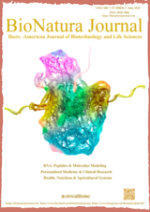Immobilization of Bromelain from Pineapple Core by Chitosan-Alginate and Its Application in Virgin Coconut Oil Production
Jaya Hardi 1,*, Ahmad Ridhay 1 , Aini Auliana Amar 1, Hardi Ys 1, Dini Dwi Yunia 1, Sutra Ayu 1, An-Nisa C.A. Samudin 1, Jerry Marcel Paesa 1
1 Department of Chemistry, Faculty of Mathematics and Natural Sciences, Tadulako University, Palu, Central Sulawesi, 94118, Indonesia
* Correspondence: jr.hardi0803@gmail.com
ABSTRACT
This study presents an innovative approach to producing virgin coconut oil (VCO) using crude bromelain extracted from pineapple core and immobilized in a chitosan-alginate matrix. The immobilization significantly improved enzyme stability, allowing for repeated use up to 15 cycles while retaining over 50% of its relative activity. Key process parameters—including a bromelain to coconut cream ratio of 1:8 (w/v), an incubation temperature of 40°C, and chitosan: alginate ratio of 7:10 (v/v)—resulted in a maximum VCO yield of 38.99%.
The resulting VCO exhibited excellent physicochemical and organoleptic qualities, with a high lauric acid content of 61.07%, meeting commercial standards. Infrared (FTIR) and GC-MS analyses confirmed the presence of characteristic ester groups and fatty acid profiles. Compared to free bromelain, the immobilized form offers a cost-effective and sustainable solution for large-scale VCO production by enabling enzyme reuse and reducing process waste.
These findings highlight the potential of chitosan-alginate immobilized bromelain as a reusable biocatalyst, offering a practical and scalable alternative for enzymatic VCO extraction with enhanced yield and product quality.
Keywords: bromelain; enzyme immobilization; chitosan-alginate beads; agro-industrial waste; pineapple by-products; virgin coconut oil; sustainable biocatalysis; protease stability; reusable enzymes
INTRODUCTION
Bromelain enzyme can be used to manufacture virgin coconut oil (VCO). Crude bromelain can be extracted from several parts of the pineapple plant, one of which is from the pineapple core 1. Bromelain can catalyze protein hydrolysis or break down protein globules that cover the oil, accelerating the process of making VCO without reducing its quality 2. VCO is a processed product from coconut cream that contains up to 67% medium-chain saturated fatty acids (MCFA), which is dominated by lauric acid (more than 50%) 3,4. MCFA compounds in VCO have the advantage of increasing the immune system because they have antibacterial and antiviral activity and can help the body absorb calcium and amino acids 5.
Free crude bromelain has been widely studied as a protein-breaking enzyme in VCO 6–8 manufacturing. The ratio of coconut cream to the volume of free bromelain has been reported at 800:600 (v/v) and produces VCO with a yield of 12% 8. The main disadvantage of free bromelain is that it can only be used once; thereby, oil production costs are high. These problems can be overcome by using immobilization techniques. Immobilized enzymes can be used continuously, which increases enzyme stability 9.
The immobilization technique commonly used in several research was the entrapment method because it was simple. Alginate is one of the most frequently used immobilizing compounds. Bromelain that is immobilized by alginate in manufacturing VCO can produce VCO with a relative activity of >50% until the sixth use 10. The number of repeated uses of these studies could still be increased by using additional immobilizers. Chitosan was chosen as an additional immobilizer because of its insolubility in water and non-toxic 11; therefore, it was very suitable for bromelain immobilization applications in the manufacturing of VCO. Chitosan has also been used as a carrier for several enzymes, such as trypsin 12, galactosidase 13, and bromelain 14. Combining alginate and chitosan as a bromelain immobilizer is expected to increase the stability of the enzyme. The entrapment efficiency of bromelain in the alginate-chitosan matrix is also high compared to using only a single alginate matrix 15. The diffusion of the enzyme from the alginate-chitosan matrix is very low, and the activity of immobilized compounds remains high; therefore, it is very suitable for bromelain immobilization 16.
MATERIAL AND METHODS
Crude bromelain extraction from pineapple core
Pineapple cores were obtained from young pineapple harvested from a pineapple plantation in Kulawi, Central Sulawesi, Indonesia. The pineapple core was cut into small pieces and mashed with phosphate buffer pH 6.5 with a 6:1 (w/v) 17 ratio. The mixture was filtered, and the filtrate was added with ammonium sulfate, which had a saturation level of 60%. The mixture was stirred until the ammonium sulfate was dissolved entirely, and then the mixture was allowed to stand for 24 hours in the refrigerator. The coagulated enzyme proteins were separated using centrifugation for 25 minutes at 3500 rpm. The residue of crude bromelain was dried at 400C for 12 hours in a vacuum oven 18.
Immobilization of crude bromelain
Crude bromelain enzyme (1.33%) in phosphate buffer was mixed with 2.5% sodium alginate solution (Sigma-Aldrich) at a ratio of 1:1 (v/v) and then put into a syringe. The mixture of bromelain and alginate was dropped into a mixed solution of 0.1M CaCl2 (Merck), 0.5% chitosan solution (Sigma-Aldrich), and 0.5% acetic acid (Merck). The chitosan:alginate ratio of 0:10, 3.5:10, 7:10, and 10,5:10 (v/v). The formed beads are left submerged in the solution of CaCl2 for 2 hours. The beads that have been separated from the solution were immobilized bromelain, which will be used in the production of VCO 19–22.
Production of VCO. The flesh of the old coconut was grated and added with water at a ratio of 1:1 (w/v) to obtain the coconut milk. Strained coconut milk was allowed to stand for 2 hours, and the top layer was separated as coconut cream 23. The immobilized crude bromelain was put into a reactor containing coconut cream in various ratios of 1:3, 1:4, 1:5, 1:6, 1:7, 1:8, and 1:9 (w/v). The mixture was allowed to stand for 36 hours. After 3 layers were formed, the oil or VCO layer was separated from the protein and water layers 24. The same treatment was carried out on free bromelain. The quality of VCO was determined by analyzing yield, water content, free fatty acid content, and organoleptic properties. Functional groups of VCO were determined by using a Spectrophotometer FTIR 8201PC Shimadzu. The fatty acid profile was analyzed using GC-MS QP2010S Shimadzu.
The efficiency of repeated use of immobilized bromelain
The coconut cream was mixed with immobilized crude bromelain. The mixture was allowed to stand for 36 hours, then the VCO layer was separated from the other layers, and the yield was determined. The immobilized bromelain from the first use was washed with deionized water and phosphate buffer at pH 6.5 and then filtered and reused to produce VCO 25. Bromelain is used continuously up to six times. The effectiveness of repeated use of immobilized bromelain was determined using a linear equation of the curve of repeated use of the enzyme vs. the relative activity of the enzyme in producing VCO.
RESULTS
The study results, and corresponding figures illustrating each experimental outcome are presented below.
This schematic illustrates the entrapment process of bromelain within the alginate-chitosan matrix. The matrix is formed via electrostatic interactions between carboxyl groups in alginate and amino groups in chitosan, creating stable beads that encapsulate the enzyme for subsequent applications in VCO production.
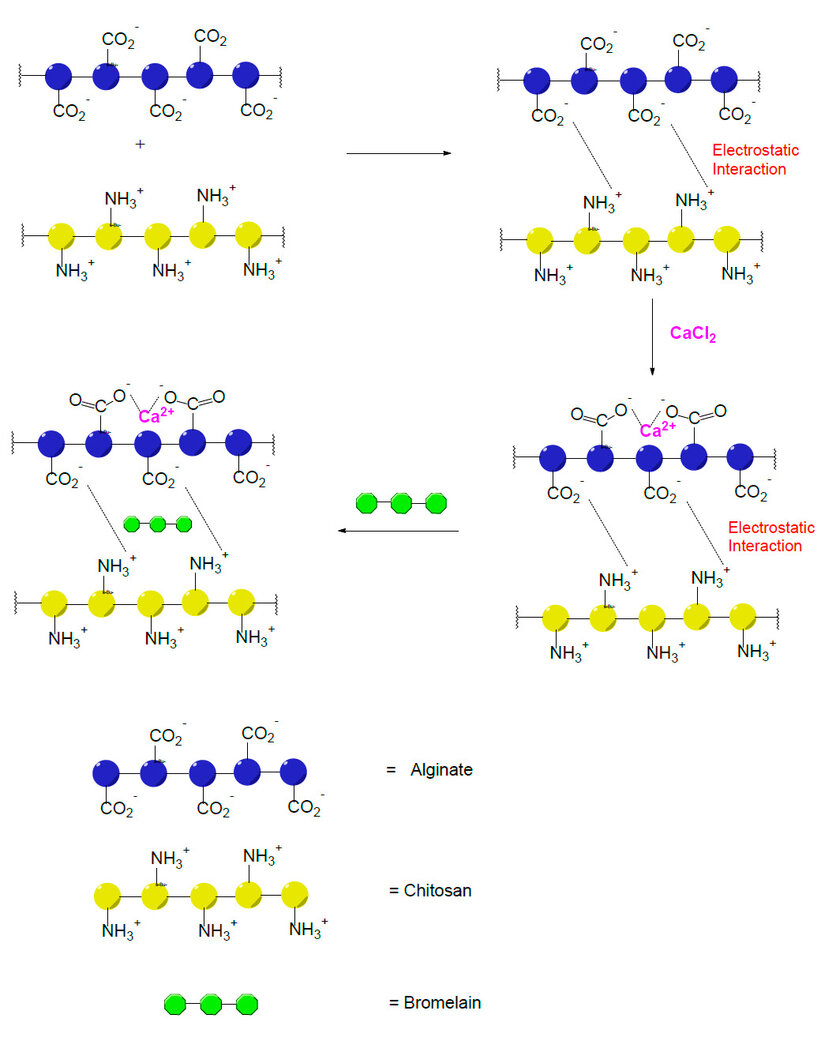
Figure 1. Alginate-chitosan matrix formation and its interaction with bromelain
To maximize VCO yield, an experiment was conducted to determine the optimal mass ratio of immobilized bromelain to coconut cream (1:3 to 1:9 w/v). The results show that the yield increased with more coconut cream, peaking at a 1:8 ratio, after which a decline was observed, likely due to reduced enzymatic activity in more acidic conditions.
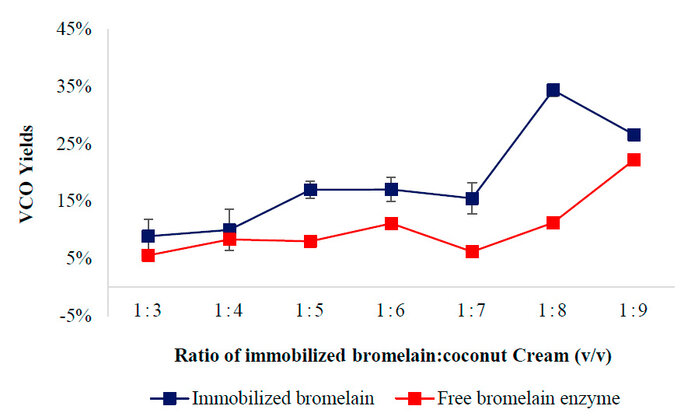
Figure 2. Effect of the ratio of immobilized bromelain: coconut cream on VCO yield
This experiment assessed the impact of temperature on enzymatic efficiency during VCO production. The highest yield was obtained at 40°C, with a noticeable decrease at higher temperatures, indicating thermal denaturation of bromelain above its optimum temperature.

Figure 3. Effect of incubation temperature on VCO yield
Various chitosan: alginate ratios (0:10 to 10.5:10 v/v) were tested to optimize the matrix composition. The highest VCO yield (38.99%) was achieved at a 7:10 ratio, suggesting that this composition provides optimal enzyme entrapment and activity without excessively hindering substrate diffusion.
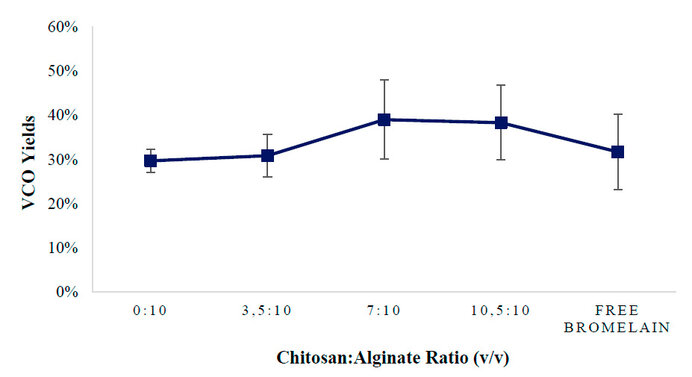
Figure 4. Effect of the ratio chitosan: alginate on VCO yield
The reusability of immobilized bromelain was evaluated over six consecutive VCO production cycles. The results show a gradual decline in yield with each reuse, attributed to matrix degradation and enzyme leaching over time.
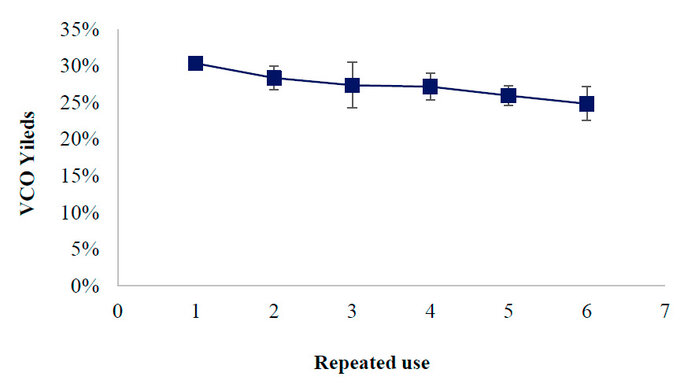
Figure 5. Repeated use of immobilized bromelain
To assess long-term effectiveness, the relative activity of immobilized bromelain was plotted against the number of reuses. Based on extrapolation, the enzyme maintained over 50% activity up to the fifteenth cycle, demonstrating good reusability for cost-effective VCO production.
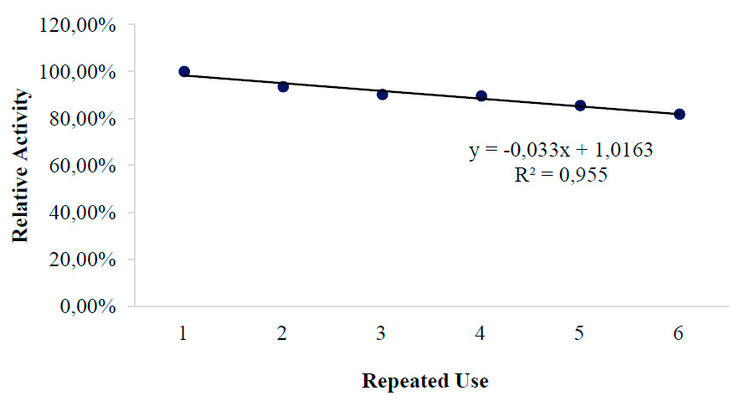
Figure 6. Relative activity of the enzyme on repeated use of immobilized bromelain
Gas chromatography was used to analyze the fatty acid composition of the produced VCO. The chromatogram reveals a dominant peak at a retention time of 24.8 minutes, corresponding to lauric acid, confirming its predominance in the product.
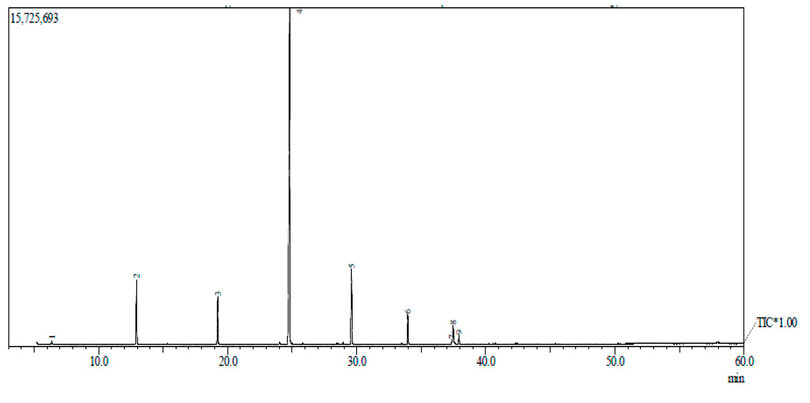
Figure 7. Chromatogram of VCO product
Mass spectrometry analysis of the VCO methyl ester derivatives confirmed the presence of lauric acid, with fragmentation patterns consistent with methyl laurate. Key ions at m/z 74, 87, and 183 validate the compound's identity.
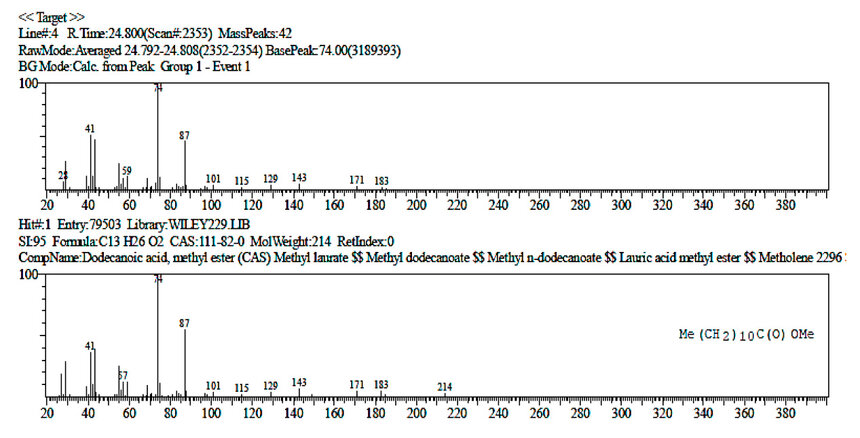
Figure 8. VCO mass spectrophotometer spectrum and comparative literature
Fourier-transform infrared spectroscopy (FTIR) analysis of the VCO showed characteristic absorption bands at 1744 cm⁻¹ (C=O ester), 2932 and 2855 cm⁻¹ (–CH₂ and –CH₃ groups), and 1158 cm⁻¹ (C–O), consistent with the typical profile of coconut oil esters.
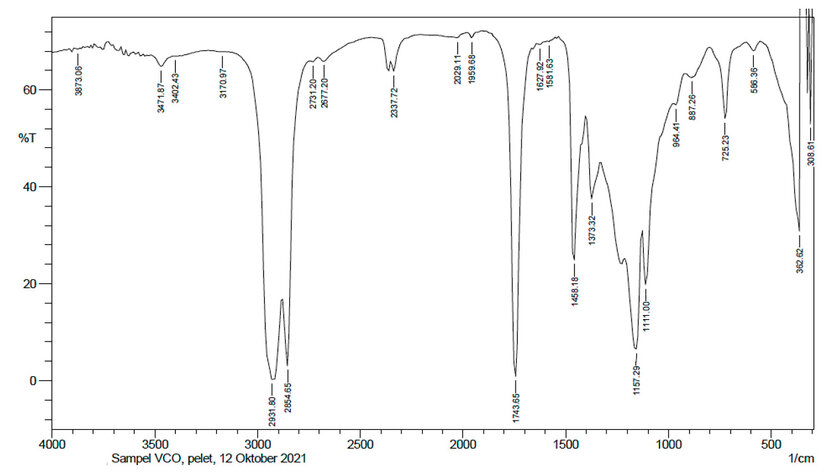
Figure 9. Infrared spectrum of VCO

Table 1. Comparison of bromelain immobilization methods regarding yield, reusability, enzyme activity, and estimated cost.
Overall, the experimental results demonstrate that bromelain immobilized within a chitosan-alginate matrix effectively enhances the yield and quality of virgin coconut oil production. Optimal conditions—namely, a bromelain to coconut cream ratio of 1:8 (w/v), incubation temperature of 40°C, and chitosan: alginate ratio of 7:10 (v/v)—resulted in the highest VCO yield. The immobilized enzyme exhibited substantial stability and reusability, maintaining over 50% of its relative activity after 15 cycles. Furthermore, as confirmed by GC-MS and FTIR analyses, the VCO produced met quality standards regarding fatty acid composition, particularly with high lauric acid content and favorable physicochemical properties. These findings highlight the potential of enzyme immobilization in improving the efficiency and economic feasibility of enzymatic VCO production.
DISCUSSION
Bromelain enzyme extraction was carried out using young pineapple hump as the essential ingredient. Protease activity in pineapple fruit will continue to increase during fruit development and decrease in the final period of fruit ripening 26. The crude bromelain obtained is 28.245 g from 2.08 kg of the wet hump. Using chitosan as a carrier is expected to increase the stability of the immobilizer gel so that repeated use has a more extended period. Takahashi et al. 990 reported that when alginate is mixed with chitosan, strong ionic interactions occur between the carboxyl residues of alginate and the amino-terminal of chitosan to form polyelectrolyte complexes 19. This complex is insoluble with the presence of Ca2+ chelate or anti-gelling cation. Therefore, CaCl2 can stabilize the gel and reduce the porosity of alginate beads 27. An alginate-chitosan matrix in immobilizing bromelain can produce a strong and hard gel. Therefore, it is not easy to leak. The resulting immobilized bromelain was either beads or spherical in shape. The alginate-chitosan‑ matrix is formed due to the electrostatic interaction between COO- ions from alginate and NH3+ ions from chitosan 28,29, and bromelain is described as being trapped in the formed matrix (Figure 1).
Optimum conditions for VCO production
Bromelain, which was immobilized by alginate-chitosan, was used for VCO production. Bromelain, which includes proteolytic enzymes, can break down lipoprotein bonds in fat emulsions 2. Therefore, it can help the process of forming a VCO. Bromelain has been immobilized with several types of natural matrices, such as chitosan, chitosan-carboxymethyl chitosan, and clay-carboxymethylcellulose 30,31,32. The stability of bromelain is enhanced by using immobilization techniques. The mass ratios of immobilized bromelain and coconut cream used in this study were 1:3, 1:4, 1:4, 1:5, 1:6, 1:7, 1:8, and 1:9 (w/v). The results showed that the yield of VCO increased with the increasing volume of coconut cream until the ratio of 1:8 and decreased at a ratio of 1:9 (Figure 2).
The highest VCO yield of 34.375% was found in the immobilized bromelain: coconut cream ratio of 1:8 (w/v). The decreasing yield on the use of a 1:9 ratio occurred because the acidity of coconut cream began to increase. Coconut cream has a pH of approximately 5.45 33, while bromelain has optimum activity in the pH range of 6.5-7 34,35; therefore, the enzyme activity was inhibited. Immobilized bromelain also has a higher activity than free enzymes. The bromelain enzyme not only contains proteases but also peroxidase 36. Therefore, in the free state, peroxidase will quickly work to accelerate oxidation in oil, which can reduce the yield of VCO.
Utilization of an incubation temperature of 40oC is the optimum condition for VCO production, with a yield of 33.85% (Figure 3). A similar result was obtained for free bromelain. Incubation at more than 40oC may cause the activity of bromelain to be decreased. It indicated that the protein of enzyme bromelain will be denatured at a temperature of more than 40oC.
The highest VCO yield was found using chitosan: alginate ratio of 7:10 (v/v) with a value of 38.99% (Figure 4). The yield of VCO obtained was higher than free bromelain or without immobilization at 31.67%. Immobilization of bromelain with alginate matrix resulted in a VCO yield of 33% 10. Using a chitosan-alginate matrix successfully increased immobilized bromelain's effectiveness in producing VCO. Enzyme activity has reached its optimum at a ratio of 7:10 (v/v) because the trapping matrix can keep the enzyme from being easily released and dissolved during the hydrolysis reaction of coconut milk protein.
Nevertheless, at the ratio of 10.5:10 (v/v), the yield of the resulting VCO began to decrease because the immobilizer matrix was very thick, and the enzyme's active site was difficult to react with the coconut cream protein substrate 19–22. The highest concentration of chitosan is thought to cause the formation of many hydrogen bonds between the amine group (-NH2) and hydroxyl group (-OH) of chitosan with bromelain protein, which can cause changes in the structure of the active site of bromelain. Theoretically, one of the weaknesses of the enzyme immobilization technique is the reduction in its enzymatic activity. Changes in the active site of bromelain can reduce proteolytic activity, which leads to a decrease in VCO products. Using chitosan: alginate ratio of 7:10 is a composition that does not significantly change the structure of the active site of bromelain; thus, its proteolytic activity is maintained. Chitosan derivatives at low levels have not been reported to substantially affect the bromelain structure 31.
The effectiveness of immobilized bromelain
The results of the repeated use of immobilized bromelain showed that the enzyme activity in producing VCO decreased with each use (Figure 5). In the first use of immobilized bromelain, the yield of VCO produced was 30.655%, then it continued to decrease on the second to sixth use, respectively 29.365%, 25.099%, 26.19%, 24.107%, and 23.512%. The decrease occurred because the alginate-chitosan matrix's thickness was depleted until the enzymes started to release. The chitosan matrix also undergoes swelling, which causes the release of the active substance 37. The more often the use of enzymes is carried out; the more enzymes begin to be included in the reaction products. Therefore, the enzyme activity decreases in the subsequent repeated use.
The effectiveness of repeated immobilized bromelain was determined based on the relative activity at the time of VCO production. The results showed that until the sixth use, the relative activity of immobilized bromelain in separating VCO from coconut cream was still at 81.83% (Figure 6). The activity of the immobilized enzyme decreased because the matrix lost stability due to repeated use 38. The decreasing activity of immobilized enzymes on repeated use can also be caused by enzyme denaturation during reuse 39.
The straight-line equation y = -0.033x + 1.0163 was used to determine the limit for repeated use of immobilized bromelain (Figure 6). The calculation results show that the repeated use of immobilized bromelain in VCO production has a maximum limit of 15 uses with a relative activity value of 52.13% or more than 50%. The effectiveness of immobilization is known from the enzyme activity, which still has a relative activity of more than 50% 39. In a previous study, the effectiveness of repeated use of alginate-immobilized bromelain on VCO production only lasted up to 6 repeated uses 10. In another study, immobilized bromelain in CNBr-Sepharose CL 4B matrix could be used repeatedly up to 15 times with a relative enzyme activity of 53.14% 40. The physical properties of the obtained VCO also meet the Asia Pacific Coconut Community (APCC) standards and Indonesian National Standard (SNI), namely the aroma that is not rancid, colorless, and has a distinctive oil taste. Economically, the utilization of immobilized bromelain for VCO production is very profitable. Pure bromelain (Sigma-Aldrich CAS: 37189-34-7) is around 105 USD per 10 grams. Free bromelain can only be used once, so producing VCO in large quantities requires much cost. Chitosan-alginate immobilized bromelain is assumed to be able to be used up to 15 times. Moreover, the price of chitosan and alginate is relatively cheap and easy to produce. Therefore, chitosan-alginate immobilized bromelain is predicted to save up to 10-12 times cheaper production costs.
Fatty acid profile of VCO
One of the quality aspects of VCO is the fatty acid content. Lauric acid is the dominant component in VCO, with a concentration of more than 50%. The lauric acid content in VCO has many health benefits, such as antiviral 41 and antibacterial 42. The fatty acid content in VCO was analyzed using GC-MS. The gas chromatography results showed the presence of the dominant compound at a retention time of 24.8 minutes (peak no.4) with a concentration of 61.07% (Figure 7).
The results of the interpretation of the MS spectrum showed that the retention time was 24.8 minutes with a concentration of 61.07% lauric acid. VCO was derivatized into methyl esters to be analyzed using GC-MS. In the MS spectrum, fragmentation results are seen with values of 74 m/z and 87 m/z, which are the base peaks of methyl laurate (Figure 8). The result of fragmentation between the carbonyl and methoxy groups was shown on the m/z 183 fragmentation pattern 43,44. Lauric acid is the highest fatty acid in the resulting VCO product of 61.07%. There are also other types of fatty acids, including caproic acid at 0.41%, caprylic acid at 9.41%, capric acid at 7%, myristic acid at 12.48%, palmitic acid at 4.72%, stearic acid at 1.27%, oleic acid 3.01%, and linoleic acid of 0.63%.
VCO characteristics
The infrared spectrum can also show the success of separating VCO from coconut cream using bromelain immobilized by an alginate-chitosan matrix. The analysis showed absorption at wave number 2932 cm-1 and 2855 cm-1, which were -CH3 and -CH2 groups, and absorption at wave number 1744 cm-1 as -C=O groups of ester compounds (Figure 9). Meanwhile, the wave number of 1158 cm-1 is absorbed from the –C-O group. The commercial VCO has absorption at wave number 2922 cm-1 and 2856 cm-1 as alkyl groups (-CH3 and –CH2) and typical oil absorption at wave number 1743 cm-1 as carbonyl absorption (-C=O) of the ester group 45.
Free fatty acid content, moisture content, and peroxide value significantly affect the quality of VCO. High water content causes oil hydrolysis to form free fatty acids. High peroxide will cause oxidation of the free fatty acids in VCO, which causes rancidity in the oil. Moisture content, free fatty acid content, and peroxide value were obtained at 0.13%, 0.33%, and 2.67 mek/kg oil, respectively. Standardization of VCO from the Indonesian National Standard (SNI), namely moisture content <0.2%, free fatty acid content <0.2%, and peroxide value <2.0 mek/kg; while Malaysia Standardization (MS), namely moisture content <0.15%, free fatty acid content <0.5%, and peroxide value <3 mek/kg oil. The VCO obtained needs to be purified using the adsorption method to reduce the values of these three parameters.
From an economic perspective, immobilized crude bromelain significantly reduces enzyme-related costs in VCO production. Commercial bromelain costs approximately 105 USD per 10 grams, and when used in free form, it is discarded after a single use. In contrast, immobilized bromelain in the chitosan-alginate matrix retains sufficient activity for up to 15 cycles, potentially lowering enzyme costs by over 85%. Moreover, both chitosan and alginate are low-cost, naturally derived materials, making this system a cost-effective and scalable solution for industrial applications.
CONCLUSIONS
This study presents a novel and cost-effective approach for enhancing virgin coconut oil (VCO) production by immobilizing crude bromelain extracted from pineapple core using a chitosan-alginate matrix. Combining these two natural polymers successfully improved the enzyme's stability, activity, and reusability—addressing a significant limitation of free bromelain use in industrial applications.
Under optimized conditions—specifically, a bromelain to coconut cream ratio of 1:8 (w/v), incubation temperature of 40°C, and chitosan: alginate ratio of 7:10 (v/v)—the highest VCO yield of 38.99% was achieved. Notably, the immobilized enzyme retained over 50% of its activity after 15 consecutive uses, significantly outperforming previously reported immobilization systems and offering a promising alternative for reducing enzyme-related production costs.
In addition, the produced VCO exhibited desirable physicochemical and organoleptic properties and a high lauric acid content (61.07%), comparable to or exceeding commercial standards. The integration of enzyme immobilization with agro-industrial byproducts (pineapple core and coconut) further enhances the sustainability and scalability of the process.
These findings underscore the innovation and industrial relevance of using chitosan-alginate immobilized bromelain as a reusable biocatalyst in high-quality VCO production.
Author Contributions: Conceptualization, Jaya Hardi and Ahmad Ridhay; methodology, Dini Dwi Yunia, Sutra Ayu, An-Nisa C. A. Samudin, and Jerry Marcel Paesa; formal analysis, Aini Auliana Amar; writing—original draft preparation, Jaya Hardi and Hardi Ys; writing—review and editing, Jaya Hardi. All authors have read and agreed to the published version of the manuscript.
Funding: The name of DIPA BLU of Tadulako University funded this research, grant number 3013/UN28/KU/2021.
Institutional Review Board Statement: Not applicable
Informed Consent Statement: Not applicable
Data Availability Statement: The data supporting this article have been included as part of this article.
Acknowledgments: Acknowledgments are given to the leadership of Tadulako University and the Faculty of Mathematics and Natural Sciences, who have provided research grants from DIPA BLU in 2021.
Conflicts of Interest: The authors declare no conflict of interest.
REFERENCES
1. Bahri S, Hadati KS, Satrimafitrah P. Production of protein hydrolysate from tofu dregs using the crude extract of bromelain from pineapple core (Ananas comosus l). J Phys: Conf Ser. 2021;1763(1):012008.
2. Janurianti NMD, Sudiarta IW, Semariyani AAM. Technological Engineering for Traditional Coconut Oil Making. SEAS (Sustainable Environment Agricultural Science). 2018;2(2):121–128.
3. Sundrasegaran S, Mah SH. Extraction Methods of Virgin Coconut Oil and Palm-pressed Mesocarp Oil and their Phytonutrients. eFood. 2020;1(6):381–391.
4. Suryani S, Sariani S, Earnestly F, Marganof M, Rahmawati R, Sevindrajuta S, Mahlia TMI, Fudholi, A. A Comparative Study of Virgin Coconut Oil, Coconut Oil and Palm Oil in Terms of Their Active Ingredients. Processes. 2020;8(4):402.
5. DebMandal M, Mandal S. Coconut (Cocos nucifera L.: Arecaceae): in health promotion and disease prevention. Asian Pac J Trop Med. 2011;4(3):241–247.
6. Soo PP, Ali Y, Lai OM, Kuan CH, Tang TK, Lee YY, Phuah E. Enzymatic and Mechanical Extraction of Virgin Coconut Oil. European Journal of Lipid Science and Technology. 2020;122(5):1900220.
7. Palilingan S, Pungus M. Produksi enzimatis Virgin Coconut Oil (VCO) dengan enzim bromelin serta pemurniannya menggunakan adsorben zeolit. Fullerene Journ Of Chem. 2018;3(2):70–74.
8. Effendi AM, Pratjojo W, Sumarni W. Optımalısası Penggunaan Enzım Bromelın Darı Sarı Bonggol Nanas Dalam Pembuatan Mınyak Kelapa. Indonesian Journal of Chemical Science. 2012;1(1).
9. Yandri, Amalia P, Suhartati T, Hadi S. Effect of Immobilization Towards Thermal Stability of a-Amylase Isolated from Locale Bacteria Isolate Bacillus subtilis ITBCCB148 with Calcium Alginate. Asian J Chem. 2013;25(12):6897–6899.
10. Hardi, J, Buheli, R., & Ridhay, A. Repeated use of bromelain immobilized on alginate membrane for virgin coconut oil production. AIP Conference Proceedings. The 3-rd International Seminar of Sciences and Technologi, Palu. AIP Publishing. 2023; 2719, 030028. https://doi.org/10.1063/5.0133259
11. Ngo DH, Vo TS, Ngo DN, Kang KH, Je JY, Pham HND, Byun H, Kim S. Biological effects of chitosan and its derivatives. Food Hydrocolloids. 2015;51:200–216.
12. Kamburov M, Lalov I. Preparation of Chitosan Beads for Trypsin Immobilization. Biotechnology & Biotechnological Equipment. 2012;26(sup1):156–163.
13. Biró E, Németh AS, Sisak C, Feczkó T, Gyenis J. Preparation of chitosan particles suitable for enzyme immobilization. J Biochem Biophys Methods. 2008;70(6):1240–1246.
14. Sya’bana M, Nawfa R. Optimasi Amobilisasi Bromelin Menggunakan Matriks Pendukung Kitosan. Jurnal Sains dan Seni ITS. 2016;5(2):130286.
15. Setiasih S, Reyhan A, Hudiyono S, Saepudin E. Dissolution Study of Purified Bromelain from Pineapple Cores (Ananas comosus [L.] Merr) Encapsulated in Alginate-Chitosan Microcapsule. J Phys: Conf Ser. 2019;1245(1):012037.
16. Oktarina E, Adrianto R, Setiawati I. Immobılısası Bakterı Pada Kıtosan-Algınat Dan Kıtın-Algınat. Majalah TEGI. 2017;9(2).
17. Gautam SS, Mishra SK, Dash V, Goyal AK, Rath G. Comparative study of extraction, purification and estimation of bromelain from stem and fruit of pineapple plant. The Thai Journal of Pharmaceutical Sciences. 2010;34(2):67–76.
18. Hardi J, Diharnaini D. Utilization of Protease from Biduri Sap for Production Windu Shrimp Flavor (Penaeus monodon). Natural Science: Journal of Science and Technology. 2014;3(2).
19. Albarghouthi M, Fara DA, Saleem M, El-Thaher T, Matalka K, Badwan A. Immobilization of antibodies on alginate-chitosan beads. Int J Pharm. 2000;206(1–2):23–34.
20. Mesla W, Mahdi C, Sutrisno S. Optimasi Amobilisasi Xilanase dari Trichoderma Viride Menggunakan Matriks Ca-alginat-kitosan. Jurnal Ilmu Kimia Universitas Brawijaya. 2014;2(1):117-121.
21. Pereira A da S, Diniz MM, De Jong G, Gama Filho HS, dos Anjos MJ, Finotelli PV, Fontes-Sant’Ana GC, Amaral PFF. Chitosan-alginate beads as encapsulating agents for Yarrowia lipolytica lipase: Morphological, physico-chemical and kinetic characteristics. International Journal of Biological Macromolecules. 2019;139:621–630.
22. Rezakhani N, Etemadzade S. Immobilization of protease in biopolymers (mixture of alginate-chitosan). Journal of Paramedical Sciences (JPS). 2014;5(4):108–113.
23. Asiah N, Astuti RM, Cempaka L, Setiani R. Physical and Chemical Characteristic of Virgin Coconut Oil under Mix Culture Fermentation Technique. J Phys: Conf Ser. 2019;1364(012009).
24. Harimurti S, Rumagesan RM, Susanawati. Environmentally friendly production method of virgin coconut oil using enzymatic reaction. IOP Conf Ser: Mater Sci Eng. 2020;874(012004).
25. Colmenares JMG, Cuellar JCR. Immobilization of bromelain on cobalt-iron magnetic nanoparticles (CoFe2O4) for casein hydrolysis. Revista Colombiana de Química. 2020;49(1):3–10.
26. Gortner WA, Singleton VL. Chemical and Physical Development of the Pineapple Fruit III. Nitrogenous and Enzyme Constituents. Journal of Food Science. 1965;30(1):24–29.
27. Cahyaningrum SE, Herdyastuti N, Qomariah N. Synthesis and Characterization of Chitosan- Alginate for Controlled Release of Isoniazid Drug. Indonesian Journal of Chemistry. 2015;15(1):16–21.
28. Venkatesan J, Bhatnagar I, Kim SK. Chitosan-Alginate Biocomposite Containing Fucoidan for Bone Tissue Engineering. Marine Drugs. 2014;12(1):300–316.
29. Untari B, Wijaya DP, Mardiyanto M, Herlina H, Angraeni V, Firana A. Physical Interaction Of Chitosan-Alginate Entrapping Extract Of Papaya Leaf And Formation Of Submicron Particles Dosage Form. Sci Technol İndones. 2019;4(3):64-69.
30. Holyavka MG, Goncharova SS, Artyukhov VG. Various Options for Covalent Immobilization of Cysteine Proteases—Ficin, Papain, Bromelain. International Journal of Molecular Sciences. 2025;26(2):547. https://doi.org/10.3390/ijms26020547
31. Holyavka MG, Goncharova SS, Sorokin AV, Lavlinskaya MS, Redko YA, Faizullin DA, Baidamshina DR, Zuev YF, Kondratyev MS, Kayumov AR, et al. Novel Biocatalysts Based on Bromelain Immobilized on Functionalized Chitosans and Research on Their Structural Features. Polymers. 2022;14(23):5110. https://doi.org/10.3390/polym14235110
32. Pimcharoen K, Opaprakasit P, Yingchutrakul Y, Simanon N, Butkinaree C, Yuttayong D, Hompa R, Vayachuta L, Prompinit P. Bromelain Immobilized onto Clay-Carboxymethylcellulose Composites for Improving Nutritive Value of Soybean Meal. ACS Appl. Bio Mater. 2024; 7(8): 5211–5221. https://doi.org/10.1021/acsabm.4c00392
33. Ariningsih S, Hasrini RF, Khoiriyah A. Analysis of Coconut Milk Products for Development of The National Standard of Indonesian Coconut Milk Products. In: Prosiding PPIS 2020. Tangerang Selatan, Indonesia: Badan Standardisasi Nasional; 2020; 231–238.
34. Bianca Martins, Robson Rescolino, Diego De Freitas Coelho, Foued Espindola, Beatriz Zanchetta, Elias Basile Tambourgi, Edgar S. Characterization of bromelain from ananas comosus agroindustrial residues purified by ethanol factional precipitation. Chemical Engineering Transactions. 2014;37:781–786.
35. Ilyas NM, Setiasih S, Hudiyono S. Isolation and Characterization of Bromelain from The Core and Flesh of Pineapple Extracts (Ananas comosus). Chemica: Jurnal Ilmiah Kimia dan Pendidikan Kimia. 2020;21(2):133–141.
36. Debnath R, Majumder R, Singha A, Ghosh D, Maiti D. Bromelain Plus Peroxidase From Pineapple Induces Apoptosis Via Mitochondrial Dependent Pathway In Lymphoma Cells. IJPSR. 2018;9(11):4610–4618.
37. Hardi J, Sugita P, Ambarsari L. Dıssolutıon Behavıor, Stabılıty And Antı-Inflammatory Actıvıty Of Ketoprofen Coated Trıpolyphosphate Modıfıed Chıtosan Nanopartıcle. Indonesian Journal of Chemistry. 2013;13(2):149-157.
38. Nurhaeni N. Peningkatan Kestabilan Enzim Protease dari Bacillus subtilis ITBCCB148 dengan Amobilisasi Menggunakan Kalsium Alginat. Jurnal Analis Kesehatan. 2016;5(1):461–466.
39. Wang Q, Cui J, Li G, Zhang J, Li D, Huang F, Wei Q. Laccase Immobilized on a PAN/Adsorbents Composite Nanofibrous Membrane for Catechol Treatment by a Biocatalysis/Adsorption Process. Molecules. 2014;19(3):3376–3388.
40. Alexandra L, Ngadiah LF, Alexandro R, Henry JW, Novita Iskandar, Ferdinal F. Isolatıon And Immobılızatıon Bromelaın (EC 3.4.22.32) onto Cnbr-SEPHAROSE CL 4B And The Effect Towards Enzymatıc Actıvıtıes And Stabılıtıes. In: Conference: 4th Annual Meeting of Hypoxia and Oxidative Stress Studies. Jakarta: Universitas Indonesia; 2014.
41. Lieberman S, Enig MG, Preuss HG. A Review of Monolaurin and Lauric Acid: Natural Virucidal and Bactericidal Agents. Alternative and Complementary Therapies. 2006;12(6):310–314.
42. Matsue M, Mori Y, Nagase S, Sugiyama Y, Hirano R, Ogai K, Ogura K, Kurihara S, Okamoto S. Measuring the Antimicrobial Activity of Lauric Acid against Various Bacteria in Human Gut Microbiota Using a New Method. Cell Transplant. 2019;28(12):1528–1541.
43. Suaniti N, Adnyana I. Comparative Study of Gas Chromatography-Mass Spectrometry in FAME and FAEE of Virgin Coconut Oil. In: Proceeding The 4th International Conference On Theoretical and Applied Physics (ICTAP-2014). Bali: Udayana University Press; 2016. 241–245.
44. Murad AM, Vianna GR, Machado AM, da Cunha NB, Coelho CM, Lacerda VAM, Coelho MC, Rech EL. Mass spectrometry characterisation of fatty acids from metabolically engineered soybean seeds. Anal Bioanal Chem. 2014;406(12):2873–2883.
45. Binsi PK, Ravishankar CN, Srinivasa Gopal TK. Development and characterization of an edible composite film based on chitosan and virgin coconut oil with improved moisture sorption properties. J Food Sci. 2013;78(4):E526-534.
Received: February 3, 2023 / Accepted: March 3, 2025 / Published: June 15, 2025
Citation: Hardi, J.; Ridhay, A.; Amar, F.A.; Ys, H.; Yunia, D.D.; Ayu, S.; Samudin, A.C.A; Paesa, J.M. Immobilization of Bromelain from Pineapple Core with Chitosan-Alginate and Its Application in Virgin Coconut Oil Production. Bionatura journal. 2025;2 (2):8. doi: 10.70099/BJ/2025.02.021.8
Additional information Correspondence should be addressed to jr.hardi0803@gmail.com
Peer review information. Bionatura thanks anonymous reviewer(s) for their contribution to the peer review of this work using https://reviewerlocator.webofscience.com/
ISSN.3020-7886
All articles published by Bionatura Journal are made freely and permanently accessible online immediately upon publication, without subscription charges or registration barriers.
Publisher's Note: Bionatura Journal stays neutral concerning jurisdictional claims in published maps and institutional affiliations.
Copyright: © 2025 by the authors. They were submitted for possible open-access publication under the terms and conditions of the Creative Commons Attribution (CC BY) license (https://creativecommons.org/licenses/by/4.0/).
How to cite this article:
Hardi J., Ridhay A., Amar F.A., et al. Immobilization of Bromelain from Pineapple Core with Chitosan-Alginate and Its Application in Virgin Coconut Oil Production. BioNatura Journal. 2025; 2(2):8. DOI: 10.70099/BJ/2025.02.02.8
